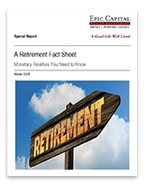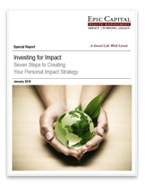Charitable Gifting in Your Estate Plan
Dec 20, 2023
 When developing your estate plan, you can do well by doing good. Leaving money to charity rewards you in many ways. It gives you a sense of personal satisfaction, and it can save you money in estate taxes.
When developing your estate plan, you can do well by doing good. Leaving money to charity rewards you in many ways. It gives you a sense of personal satisfaction, and it can save you money in estate taxes.
A few words about transfer taxes
The federal government taxes transfers of wealth you make to others, both during your life and at your death. In 2023, generally, the federal gift and estate tax is imposed on transfers in excess of $12,920,000 ($12,060,000 in 2022) and at a top rate of 40 percent. There is also a separate generation-skipping transfer (GST) tax that is imposed on transfers made to grandchildren and lower generations. For 2023, there is a $12,920,000 ($12,060,000 in 2022) exemption and the top rate is 40 percent.
The Tax Cuts and Jobs Act, signed into law in December 2017, doubled the gift and estate tax basic exclusion amount and the GST tax exemption to $11,180,000 in 2018. After 2025, they are scheduled to revert to their pre-2018 levels and cut by about one-half.
You may also be subject to state transfer taxes.
Careful planning is needed to minimize transfer taxes, and charitable giving can play an important role in your estate plan. By leaving money to charity the full amount of your charitable gift may be deducted from the value of your gift or taxable estate.
Make an outright bequest in your will
The easiest and most direct way to make a charitable gift is by an outright bequest of cash in your will. Making an outright bequest requires only a short paragraph in your will that names the charitable beneficiary and states the amount of your gift. The outright bequest is especially appropriate when the amount of your gift is relatively small, or when you want the funds to go to the charity without strings attached.
Make a charity the beneficiary of an IRA or retirement plan
If you have funds in an IRA or employer-sponsored retirement plan, you can name your favorite charity as a beneficiary. Naming a charity as beneficiary can provide double tax savings. First, the charitable gift will be deductible for estate tax purposes. Second, the charity will not have to pay any income tax on the funds it receives. This double benefit can save combined taxes that otherwise could eat up a substantial portion of your retirement account.
Use a charitable trust
Another way for you to make charitable gifts is to create a charitable trust. There are many types of charitable trusts, the most common of which include the charitable lead trust and the charitable remainder trust.
A charitable lead trust pays income to your chosen charity for a certain period of years after your death. Once that period is up, the trust principal passes to your family members or other heirs. The trust is known as a charitable lead trust because the charity gets the first, or lead, interest.
A charitable remainder trust is the mirror image of the charitable lead trust. Trust income is payable to your family members or other heirs for a period of years after your death or for the lifetime of one or more beneficiaries. Then, the principal goes to your favorite charity. The trust is known as a charitable remainder trust because the charity gets the remainder interest. Depending on which type of trust you use, the dollar value of the lead (income) interest or the remainder interest produces the estate tax charitable deduction.
There are costs and expenses associated with the creation of these legal instruments.
Why use a charitable lead trust?
The charitable lead trust is an excellent estate planning vehicle if you are optimistic about the future performance of the investments in the trust. If created properly, a charitable lead trust allows you to keep an asset in the family while being an effective tax-minimization device.
For example, you create a $1 million charitable lead trust. The trust provides for fixed annual payments of $80,000 (or 8 percent of the initial $1 million value of the trust) to ABC Charity for 25 years. At the end of the 25-year period, the entire trust principal goes outright to your beneficiaries. To figure the amount of the charitable deduction, you have to value the 25-year income interest going to ABC Charity. To do this, you use IRS tables. Based on these tables, the value of the income interest can be high — for example, $900,000. This means that your estate gets a $900,000 charitable deduction when you die, and only $100,000 of the $1 million gift is subject to estate tax.
Why use a charitable remainder trust?
A charitable remainder trust takes advantage of the fact that lifetime charitable giving generally results in tax savings when compared to testamentary charitable giving. A donation to a charitable remainder trust has the same estate tax effect as a bequest because, at your death, the donated asset has been removed from your estate. Be aware, however, that a portion of the donation is brought back into your estate through the charitable income tax deduction.
Also, a charitable remainder trust can be beneficial because it provides your family members with a stream of current income — a desirable feature if your family members won’t have enough income from other sources.
For example, you create a $1 million charitable remainder trust. The trust provides that a fixed annual payment be paid to your beneficiaries for a period not to exceed 20 years. At the end of that period, the entire trust principal goes outright to ABC Charity. To figure the amount of the charitable deduction, you have to value the remainder interest going to ABC Charity, using IRS tables. This is a complicated numbers game. Trial computations are needed to see what combination of the annual payment amount and the duration of annual payments will produce the desired charitable deduction and income stream to the family.
More Insights
At some point in our lives, we may inherit a home or another form of real property. In such instances, we need to understand some of the jargon involving inherited real estate. What does “cost basis” mean? What is a “step-up?” What is the home sale tax exclusion, and what kind of tax break does … Continue reading “Explaining the Basis of Inherited Real Estate”
Medicare won’t cover all of your health-care costs during retirement, so you may want to buy a supplemental medical insurance policy known as Medigap. Offered by private insurance companies, Medigap policies are designed to cover costs not paid by Original Medicare (Parts A and B), helping you fill the gaps in your Medicare coverage. You’ll … Continue reading “Buying Supplemental Health Insurance: Medigap”
Incapacity can strike anyone at any time. Estate Planning plans for it By definition, estate planning is a process designed to help you manage and preserve your assets while you are alive, and to conserve and control their distribution after your death according to your goals and objectives. But what estate planning means to you … Continue reading “Estate Planning Intro”
You’re beginning to accumulate substantial wealth, but you worry about protecting it from future potential creditors. Whether your concern is for your personal assets or your business, various tools exist to keep your property safe from tax collectors, accident victims, health-care providers, credit card issuers, business creditors, and creditors of others. To insulate your property … Continue reading “Estate Planning – Protecting Your Assets”
It seems like we just can’t stop talking about the Federal Reserve (Fed). After an aggressive rate hiking campaign that we think ended last year, markets were expecting the Fed to start cutting interest rates as early as next month. But withan economy that continues to surprise to the upside, along with inflationary pressures that … Continue reading “Market Update – The Patient Pause”
Services
Epic Capital provides the following comprehensive financial planning and investment management services: Learn More >


 Top of Page
Top of Page











